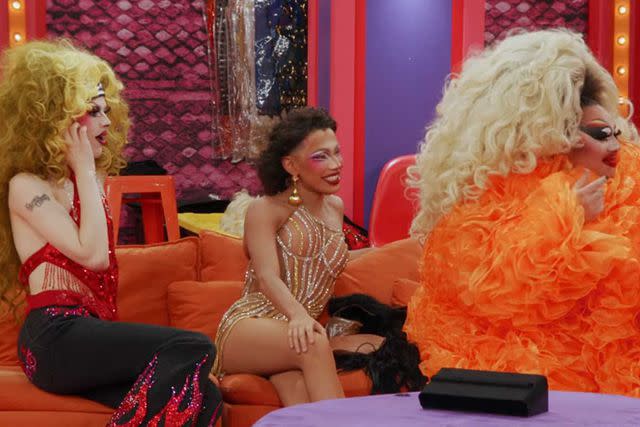RuPaul’s Drag Race All Stars 10 isn’t just a season — it’s a recalibration.
The long-running franchise has always loved a twist, a reinvention, a remix of its own mythology. But Season 10 is different. It’s not just changing the rules — it’s shifting the philosophy. The “Tournament of All Stars” structure is putting real pressure on what it means to be a frontrunner. And now, with the first six queens officially entering the semifinals, we’re seeing the shape of something both familiar and radically new.
These aren’t just six queens who did well. They’re the ones who navigated a format designed to flatten narrative favorites and reward consistent, game-aware play. And their names say everything about what this season — and arguably this moment in drag — is really about.
The Orange Bracket: Sharp Comebacks and Steady Climbs
Irene the Alien, Bosco, and Aja emerged from the Orange Bracket as the first trio to move forward. And honestly? That bracket had an air of unfinished business from the jump.
- Irene the Alien is living proof that early boots can come back as power players. Cut in Episode 1 of Drag Race Season 15, Irene entered All Stars 10 as a wildcard — but left Orange Bracket as a top scorer, thanks to strong challenge performances and the kind of absurdist drag that thrives when the format gives it room to breathe.
- Bosco, meanwhile, played the long game. She never felt like the obvious “moment” queen, but she built quiet momentum. Every choice felt specific. Every runway had something to say. And in a bracket that rewarded consistency over chaos, Bosco’s surgical coolness paid off.
- Then there’s Aja. Back again after Drag Race Season 9, All Stars 3, and a full pivot into ballroom culture and underground fame, Aja entered with something to prove — and a very different lens on drag. Her scores weren’t always the highest, but her evolution was clear. No longer caught in the edit’s “immature queen” trap, Aja came across as self-possessed, technical, and completely in control of her narrative.
If this bracket was about redemption, it delivered.
The Pink Bracket: Energy, Star Power, and Strategic Heat
From the start, the Pink Bracket had more volatility. More emotion. More brawls. But that didn’t stop Jorgeous, Lydia B. Kollins, and Mistress Isabelle Brooks from rising to the top — each with a distinct path and tone.
- Jorgeous may have been the most expected success story here, but that doesn’t make it any less satisfying. She crushed the challenge wins. She danced circles around her bracket. And most importantly, she radiated something that’s often harder to quantify: likability. Her brand of drag is pure pop pleasure, and the judges ate it up. The fans did too. But beneath the cuteness is a competitor who knows how to play clean and still win. That’s no small feat.
- Lydia B. Kollins, on the other hand, was a slow burn. Not a name that lit up Reddit or stan Twitter right out the gate, Lydia earned her spot by being unshakeable. Not flashy. Not messy. Just… good. Her performances were emotionally intelligent, her drag aesthetic was refined, and she came off as someone who could read a room and adjust accordingly — a survival trait this format demands.
- Then there’s Mistress Isabelle Brooks — a name that brings drama whether she wants it to or not. With 4.5 points, she didn’t dominate her bracket, but she controlled the edit. Mistress knows how to hold attention, stir tension, and break the fourth wall without blinking. That’s not always rewarded in traditional Drag Race seasons, but in a bracket where every queen is scored week-to-week, her ability to stay narratively central may have been the edge she needed.
The First Six In — and What That Actually Signals
This first wave into the semifinals says a lot — not just about who’s thriving, but about what All Stars 10 is actually rewarding.
They’re not the flashiest names. They’re not the most decorated. But they’ve played smart. Stayed consistent. Kept themselves narratively essential. And most importantly, they’ve aligned with the format’s true values: challenge points, week-to-week reliability, and the ability to keep delivering without burning out.
This group sets a tone. Not because they’re “the ones to beat,” but because they reveal what kind of gameplay the format favors. If you’re still treating this like a traditional All Stars season — waiting for a “Ru-favored” comeback arc or a legacy girl to be dragged to the finale — you’re missing the plot.
There are no golden tickets this time. No coasting on memes. No surviving a flop Snatch Game because you’re a fan favorite. The Tournament of All Stars demands something colder: math, strategy, self-awareness. If you can’t perform and maintain momentum, you’re out — icon status be damned.
That’s what makes this season feel different. In past All Stars outings, narrative often trumped performance. This time, the numbers are the narrative.
Drag Race in the Current Era: Relevance Is a Moving Target
What’s also worth naming is that this season exists during a broader shift in drag culture.
It’s not 2016 anymore. Drag isn’t just queer nightlife turned reality spectacle — it’s political. It’s mainstreamed. It’s been attacked by state legislatures, absorbed into fashion weeks, cited in corporate DEI briefings, and warped by TikTok algorithms. In that context, returning to Drag Race isn’t just a career choice. It’s a referendum. A relaunch. A risk.
So for queens like Aja and Irene, who’ve had to watch their first impressions become meme fodder for years, or queens like Lydia and Jorgeous, who are still defining what their post-Drag Race careers look like, All Stars 10 isn’t just a second chance. It’s a shot at legacy in a game that no longer rewards safe choices or easy branding.
What Comes Next?
Bracket Three — the Purple Group — is still in play, and the wildcard nature of that bracket makes it unpredictable. There are still huge personalities in the mix. Still room for a shocking run or a last-minute boot. But with these first six secured, the semifinals are already stacked with queens who feel both timely and timeless.
If the final bracket adds fuel to the fire, we could be looking at one of the most competitive endgames in All Stars history — not because everyone’s a legend, but because no one got here by accident.










